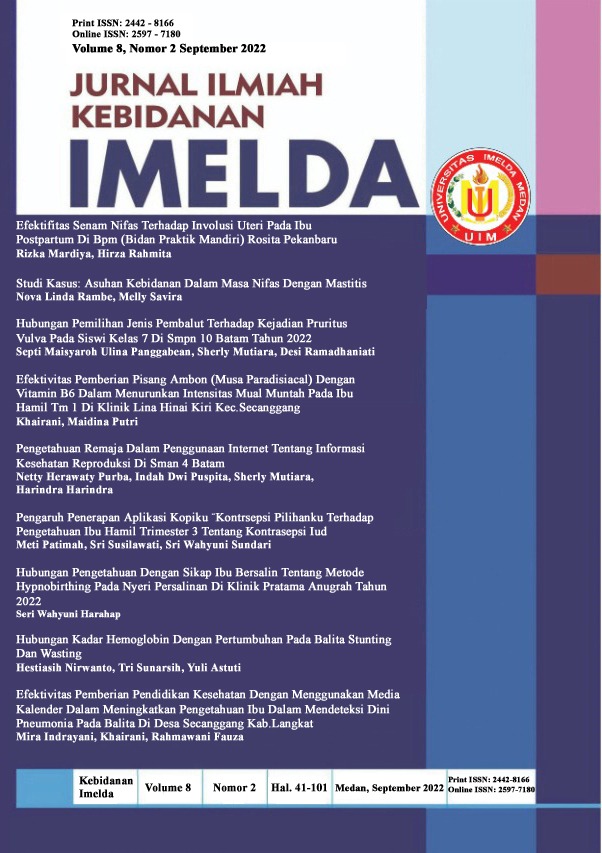EFEKTIVITAS PEMBERIAN PENDIDIKAN KESEHATAN DENGAN MENGGUNAKAN MEDIA KALENDER DALAM MENINGKATKAN PENGETAHUAN IBU DALAM MENDETEKSI DINI PNEUMONIA PADA BALITA DI DESA SECANGGANG KAB.LANGKAT
DOI:
https://doi.org/10.52943/jikebi.v8i2.1125Keywords:
Knowledge, Early Detection, Pneumonia, ToddlerAbstract
Pneumonia is one of the most serious infectious diseases in children and is one of the most common acute respiratory infections (ARI) which causes death in children under five. Pneumonia is a major cause of morbidity and mortality in children under five. Every year more than 2 million children in the world die from pneumonia and most (99%) occur in developing and least developed countries. The purpose of this study was to determine the effectiveness of providing health education using calendar media in increasing mother's knowledge in early detection of pneumonia in children under five in Secanggang Village, Kab. Langkat. This type of research uses a quasi-experimental research design with "one group pretest and posttest control group design". The population of this research is mothers who have toddlers who live in Secanggang Village totaling 98 mothers. The sampling technique in this study was purposive sampling, with a total of 40 people, namely 20 experimental samples and 20 control samples. The results of the bivariate analysis showed that there was a significant relationship between mother's knowledge in early detection of pneumonia in toddlers between those who were given health education with calendar media and without calendar media, the p-value was 0.031. Because the p-value <0.05, Ho is rejected and Ha is accepted, meaning that there is a significant relationship between the level of knowledge of parents of children under five on detecting pneumonia.
References
[2] D. . Rachmawati, “Faktor Risiko yang Berhubungan dengan Kejadian Pneumonia pada Balita Umur 12 - 48 Bulan di Wilayah Kerja Puskesmas Mijen Kota Semarang,” J. Kesehat. Masy., vol. 2, no. 1, pp. 1–10, 2013, [Online]. Available: http://ejournals1.undip.ac.id/index.php/jkm.
[3] R. K. D. (Riskesdas), “Badan Penelitian dan Pengembangan Kesehatan Kementerian RI,” 2018.
[4] S. Notoatmodjo, “Metodologi Penelitian Kesehatan Edisi Revisi, Rineka Cipta, Jakarta,” 2010.
[5] D. Suzanna, Prof. dr. Hari Kusnanto, “PEMANFAATAN MEDIA KALENDER DAN FLYER DALAM MENINGKATKAN PENGETAHUAN DAN SIKAP MASYARAKAT TERHADAP PENCEGAHAN PENYAKIT FILARIASIS DI KABUPATEN BANYUASIN,” 2011.
[6] M. L. Mayasari and B. Wahyono, “Efektivitas Penyuluhan Kesehatan Dengan Metode Ceramah Disertai Pemanfaatan Media Booklet Dalam Upaya Meningkatkan Pengetahuan Ibu Tentang Penyakit Pneumonia Pada Balita Di Kelurahan Bandarharjo Kecamatan Semarang Utara Kota Semarang Tahun 2014,” Unnes J. Public Heal., vol. 5, no. 1, p. 29, 2016, doi: 10.15294/ujph.v5i1.9701.
[7] A. N. U. R. Efendi et al., “Universitas negeri semarang 2011,” J. Ris. Manaj. dan Bisnis Fak. Ekon. UNIAT, vol. 2, no. 2, pp. 1–5, 2011.
[8] dan S. N. Umrahwati, Alfiah A, “Faktor-Faktor yang Berhubungan Dengan Kejadian ISPA Berulang pada Balita Di Puskesmas Watampone,” vol. 2013, pp. 115-122.
[9] S. Notoatmodjo, “Promosi Kesehatan: Teori dan Aplikasi, Rineka Cipta, Jakarta.,” 2003.
[10] A. P. Nugroho, “Telah disetujui oleh?:,” 2011.
[11] Susilowati, “Hubungan Antara Tingkat Pengetahuan dan Sikap Orang Tua dengan Kekambuhan ISPA pada Balita Diwilayah Kerja UPTD Puskesmas Pekalongan Selatan, Skripsi, Universitas Muhammadiyah Surakarta,” 2010.










